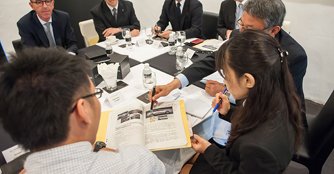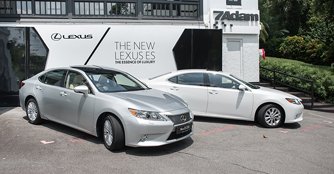What it takes to make an ES
07 Nov 2013|6,797 views
The Lexus ES has been the marque's top seller, and one of the two models that first wore the Lexus badge during the brand's inception in 1989 (the other being the flagship LS sedan). As such, it isn't hard to see the importance of the ES sedan.
The first five generations of the ES shared the same platform with its less luxuriously appointed cousin - the Toyota Camry. The latest sixth generation, though, features an increased wheelbase by using the Toyota Avalon's platform - a full-sized family sedan produced in the U.S.A.
Having left the local scene for seven years, the ES is back with greater emphasis on luxury and comfort. We snapped at the chance to speak to the very people who are responsible for putting the ES together at Lexus' Kyushu Plant (Toyota Motor Kyushu).
SGCM: What is the most challenging part in the manufacturing process of the Lexus ES?
TMK: Build quality plays a paramount role in all Lexus cars, and the ES is no exception. The challenge can be summarised in three parts: to bring it as close as possible to the drawings; exceed the drawings; and to create something that is not mentioned in the drawings.
For example the front and rear facets have to be manufactured in strict accordance to the drawings as penned to stay true to the original design. The fit and finish of all external panels are also looked into to ensure a consistent and minimal spacing between different panels. Careful attention is also paid to parts unseen by our customers - such as ensuring the welding spots form a perfect straight line even when they are covered. It is the every little single detail that makes the ES a Lexus, and it is also the biggest challenge for us.

TMK: At Toyota Motor Kyushu we use various techniques inspired by the TPS. For instance, the conveyor speed is calibrated based on the monthly orders.
From there, we assign each operator with a specific task. In the event where a work station experiences a problem, the entire production chain is paused, with immediate attention paid to the station with the problem. In this case, any problems will be rectified on the spot.
The product will only move on to the next station when it is certified correct by the skilled operators. In this case we can be assured of every product that leaves the chain to be of top most quality. This process is applied to all models that roll off the production line in Kyushu, such as the RX, CT and ISC.
SGCM: Is there a daily quota to meet at the factory?
TMK: No there isn't. The production volume highly depends on the order quantity from our dealers.
The Lexus ES has been the marque's top seller, and one of the two models that first wore the Lexus badge during the brand's inception in 1989 (the other being the flagship LS sedan). As such, it isn't hard to see the importance of the ES sedan.
The first five generations of the ES shared the same platform with its less luxuriously appointed cousin - the Toyota Camry. The latest sixth generation, though, features an increased wheelbase by using the Toyota Avalon's platform - a full-sized family sedan produced in the U.S.A.
Having left the local scene for seven years, the ES is back with greater emphasis on luxury and comfort. We snapped at the chance to speak to the very people who are responsible for putting the ES together at Lexus' Kyushu Plant (Toyota Motor Kyushu).
SGCM: What is the most challenging part in the manufacturing process of the Lexus ES?
TMK: Build quality plays a paramount role in all Lexus cars, and the ES is no exception. The challenge can be summarised in three parts: to bring it as close as possible to the drawings; exceed the drawings; and to create something that is not mentioned in the drawings.
For example the front and rear facets have to be manufactured in strict accordance to the drawings as penned to stay true to the original design. The fit and finish of all external panels are also looked into to ensure a consistent and minimal spacing between different panels. Careful attention is also paid to parts unseen by our customers - such as ensuring the welding spots form a perfect straight line even when they are covered. It is the every little single detail that makes the ES a Lexus, and it is also the biggest challenge for us.

SGCM: Besides being a renowned automaker, Toyota is also well known for its management theories, such as Toyota Management System (TPS), Lean Production, and The Toyota Way. How has these inspired the way the ES is built?
TMK: At Toyota Motor Kyushu we use various techniques inspired by the TPS. For instance, the conveyor speed is calibrated based on the monthly orders.
From there, we assign each operator with a specific task. In the event where a work station experiences a problem, the entire production chain is paused, with immediate attention paid to the station with the problem. In this case, any problems will be rectified on the spot.
The product will only move on to the next station when it is certified correct by the skilled operators. In this case we can be assured of every product that leaves the chain to be of top most quality. This process is applied to all models that roll off the production line in Kyushu, such as the RX, CT and ISC.
SGCM: Is there a daily quota to meet at the factory?
TMK: No there isn't. The production volume highly depends on the order quantity from our dealers.
Thank You For Your Subscription.






















